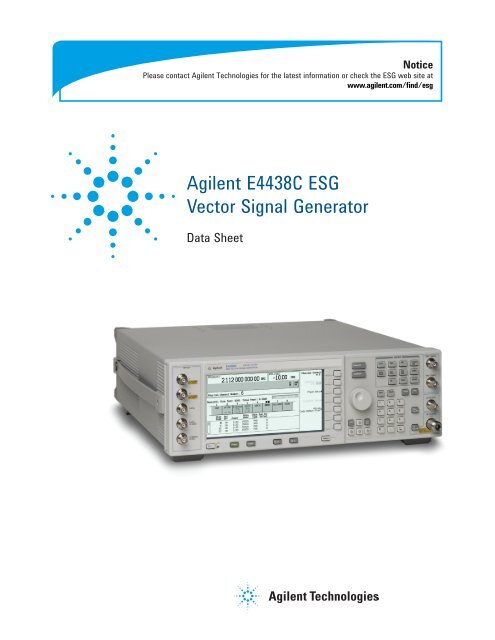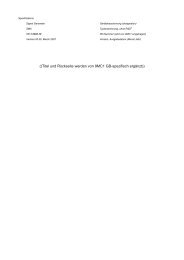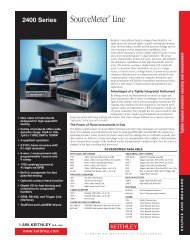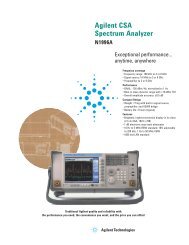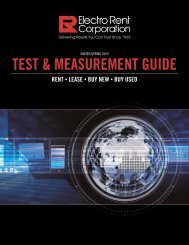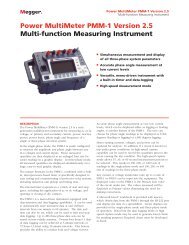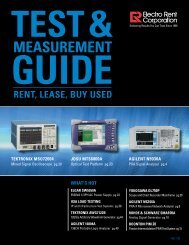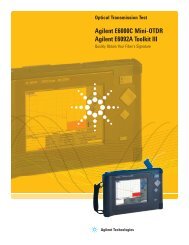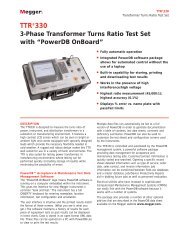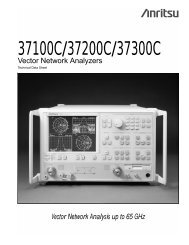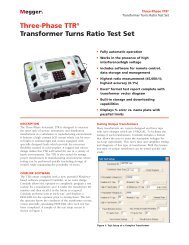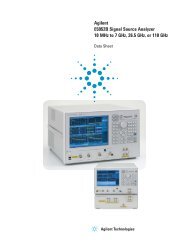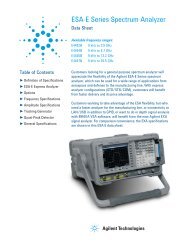Agilent E4438C ESG Vector Signal Generator - Advanced Test ...
Agilent E4438C ESG Vector Signal Generator - Advanced Test ...
Agilent E4438C ESG Vector Signal Generator - Advanced Test ...
You also want an ePaper? Increase the reach of your titles
YUMPU automatically turns print PDFs into web optimized ePapers that Google loves.
Table of ContentsIntroduction................................................................................................ 3Key Features............................................................................................... 4Specifications for Frequency and Power Characteristics.................. 5Frequency............................................................................................ 5Sweep modes...................................................................................... 5Internal reference oscillator............................................................. 5Output power...................................................................................... 6Level accuracy....................................................................... 6Repeatability and linearity................................................... 8Spectral purity................................................................................... 10Specifications for Analog Modulation................................................. 12Frequency bands.............................................................................. 12Frequency modulation..................................................................... 12Phase modulation............................................................................. 13.Amplitude modulation..................................................................... 13Wideband AM................................................................................... 14Pulse modulation.............................................................................. 14Internal modulation source............................................................ 15External modulation inputs............................................................. 15External burst envelope................................................................... 16Composite modulation..................................................................... 16Simultaneous modulation............................................................... 16Specifications for I/Q Characteristics................................................. 17I/Q modulation bandwidth............................................................. 17I/Q adjustments............................................................................... 18Baseband generator [arbitrary waveform mode]........................ 18Baseband generator [real-time mode].......................................... 20Specifications for <strong>Signal</strong> Personality Characteristics....................... 213GPP W-CDMA................................................................................. 21IS-95 CDMA....................................................................................... 22cdma2000 ® ......................................................................................... 22Enhanced multitone ........................................................................ 23AWGN................................................................................... 23Custom modulation ........................................................... 24GSM/GPRS ......................................................................... 25EDGE/EGPRS ...................................................................... 26Bit error rate [BER] analyzer............................................. 26General Characteristics.......................................................................... 27Operating characteristics................................................................ 27Inputs and outputs........................................................................... 28Ordering Information............................................................................... 34Related Literature.................................................................................... 352
Specifications forFrequency and Power CharacteristicsRepeatability and linearityRepeatability1900 MHz CW, 5 dBm, attenuator hold On, ALC OnRepeatability1900 MHz CW, 5 dBm, attenuator hold Off, ALC Off0.10.50.090.08Typical unitLimits0.450.40.070.35Powererror (dB)0.060.050.04Power error (dB)0.30.250.20.030.020.010.150.100.05Typical unitLimits00 20 40 60 80 100 120Elapsed time (minutes)00 1 2 3 4 5 6 7 8 9 10Elapsed time (minutes)Repeatability measures the ability of the instrument to return to a given powersetting after a random excursion to any other frequency and power setting.It is a relative measurement that reflects the difference in dB between themaximum and minimum power readings for a given setting over a specifictime interval. It should not be confused with absolute power accuracy, whichis measured in dBm. 10.40.30.2Lower limitLower STD deviationMeanUpper STD deviationUpper limitRelative level accuracyInitial power 7 dBm0.1Power error (dB)0-0.1-0.2-0.3-0.40 -20 -40 -60-80 -100-120-140Final power (dBm)Relative level accuracy measures the accuracy of a step change from anypower level to any other power level. This is useful for large changes (i.e. 5 dBsteps). 11. Repeatability and relative level accuracy are typical for all frequency ranges.8
Specifications forFrequency and Power CharacteristicsCharacteristic SSB phase noiseWith Option 1E5With Option UNJCW modeI/Q onCW modeI/Q onfc = 850 MHzfc = 850 MHzI/Q onI/Q onCW modeCW modefc = 1900 MHzfc = 1900 MHzI/Q onI/Q onCW modeCW modefc = 2200 MHzfc = 2200 MHzPN mode 1I/Q on or CW modePN mode 2Phase noise mode 1 and 2 at fc = 900 MHzfc = 5.7 GHz [Option 506]11
Maximum deviation 3 Standard With Option UNJSpecifications for Analog ModulationFrequency bandsBand Frequency range N number123456250 kHz to ≤ 250 MHz> 250 MHz to ≤ 500 MHz> 500 MHz to ≤ 1 GHz> 1 to ≤ 2 GHz> 2 to ≤ 4 GHz> 4 to ≤ 6 GHz10.51248Frequency modulation 1, 2ResolutionN x 8 MHzN x 1 MHz0.1% of deviation or 1 Hz, whichever is greaterModulation frequency rate 4 [deviation = 100 kHz]Coupling 1 dB bandwidth 3 dB bandwidthFM path 1[DC]FM path 2 [DC]FM path 1 [AC]FM path 2 [AC]DC to 100 kHzDC to 100 kHz20 Hz to 100 kHz20 Hz to 100 kHz(DC to 10 MHz)(DC to 0.9 MHz)(5 Hz to 10 MHz)(5 Hz to 0.9 MHz)Deviation accuracy 3 [1 kHz rate, deviation < N x 100 kHz]< ± 3.5% of FM deviation + 20 HzCarrier frequency accuracy relative to CW in DCFM 3, 5±0.1% of set deviation + (N x 1 Hz)Distortion 3 [1 kHz rate, dev.= N x 100 kHz]< 1%FM using external inputs 1 or 2SensitivityInput impedance1 V peakf or indicated deviation50 Ω, nominalFM path 1 and FM path 2 are summed internally for composite modulation.The FM 2 path is limited to a maximum rate of 1 MHz. The FM 2 path mustbe set to a deviation less than FM 1 path.1. All analog performance above 4 GHz is typical.2. For non-Option UNJ units, specifications apply in phase noise mode 2 [default].3. Refer to frequency bands on this page to compute specifications.4. Parentheses denote typical performance.5. At the calibrated deviation and carrier frequency, within 5 °C of ambient temperatureat time of calibration.12
Specifications for Analog ModulationPhase modulation 1, 2Resolution0.1% of set deviationModulation frequency response 3, 4StandardAllowable rates [3 dB BW]Mode Maximum deviation ΦM path 1 ΦM path 2Normal BWHigh BW 6N x 80 radiansN x 8 radiansN x 1.6 radiansDC to 100 kHz(DC to 1 MHz)(DC to 10 MHz)DC to 100 kHz(DC to 0.9 MHz)(DC to 0.9 MHz)With option UNJAllowable rates [3 dB BW]Mode Maximum deviation ΦM path 1 ΦM path 2Normal BWHigh BWN x 10 radiansN x 1 radiansDC to 100 kHz(DC to 1 MHz)DC to 100 kHz(DC to 0.9 MHz)Deviation accuracy [1 kHz rate, Normal BW mode]< ±5% of deviation + 0.01 radiansDistortion 3 [1 kHz rate, deviation < 80 radians on standard model, < 10 Nradians on Option UNJ models, Normal BW mode]< 1%ΦM using external inputs 1 or 2Sensitivity 1 V peakf or indicated deviationInput impedancePaths50 Ω, nominalΦM path 1 and ΦM path 2 are summed internally forcomposite modulation. The ΦM 2 path is limited to amaximum rate of 1 MHz. ΦM path 2 must be set to adeviation less than the FM path 1.Amplitude modulation 1, 6[fc > 500 kHz]1. All analog performance above 4 GHz istypical.2. For non-Option UNJ units, specificationsapply in phase noise mode 2 [default].3. Refer to frequency bands on page 12 for N.4. Parentheses denote typical performance.5. Bandwidth is automatically selected basedon deviation.6. AM is typical above 3 GHz or if widebandAM or I/Q modulation is simultaneouslyenabled.7. Peak envelope power of AM must be 3 dBless than maximum output power below250 MHz.Range 0 to 100%Resolution 0.1%Rates [3 dB bandwidth]DC coupledAC coupled0 to 10 kHz10 Hz to 10 kHzAccuracy 4, 7 1 kHz rate < ±(6% of setting +1%)Distortion 4, 7 [1 kHz rate, THD]30% AM90% AMAM using external inputs 1 or 2SensitivityInput impedancePathsOption 501-504/Option UNJ Option 506< 1.5%(< 4%)< 1.5%(< 5%)1 V peakf or indicated deviation50 Ω, nominalAM path 1 and AM path 2 are summedinternally for composite modulation.13
Specifications for Analog ModulationWideband AMPulse modulationRates [1 dB bandwidth] 1ALC onALC off(400 Hz to 40 MHz)(DC to 40 MHz)Wideband AM using external 1 input onlyOn/off ratio 1Sensitivity 0.5 V = 100%Input impedance≤ 4 GHz> 4 GHzRise/fall times 1Minimum width 1ALC onALC offPulse repetition frequency 1ALC onALC off50 Ω, nominal> 80 dB(> 64 dB)(150 ns)(2 µs)(0.4 µs)(10 Hz to 250 kHz)(DC to 1.0 MHz)Level accuracy 1, 2 [relative to CW at ≤ 4 dBm standard, ≤ 7.5 dBm Option UNB,≤ 4.5 dBm Option 506](< ±1 dB)Pulse modulation using external inputsInput voltageRF onRF offInput impedanceInternal pulse generatorSquare wave ratePulsePeriodWidthResolution> +0.5 V, nominal< +0.5 V, nominal50 Ω, nominal0.1 Hz to 20 kHz8 μs to 30 seconds4 μs to 30 seconds2 μs1. Parentheses denote typical performance.2. With ALC off, specifications apply after the execution of power search. With ALC on, specificationsapply for pulse repetition rates ≤ 10 kHz and pulse widths ≥ 5 μs.14
Specifications for Analog ModulationInternal modulation sourceProvides modulating signal for FM,AM, pulse and phase modulationsignals, and provides LF outputsource for basic functiongenerator capability.WaveformsRates rangeResolutionSine, square, ramp, triangle, pulse, noiseSineSquare, ramp, triangle0.1 Hz0.1 Hz to 100 kHz0.1 Hz to 20 kHzFrequency accuracy Same as RF reference sourceSwept sine mode [frequency, phase continuous]Operating modes Triggered or continuous sweepsFrequency range 0.1 Hz to 100 kHzSweep time 1 ms to 65 secResolution 1 msDual sinewave modeFrequency rangeAmplitude ratioAmplitude ratioresolutionLF audio out modeAmplitude0.1 Hz to 100 kHz0 to 100%0.1%0 to 2.5 V peakinto 50 ΩNoiseOutput impedance50 Ω, nominalNoise with adjustable amplitude generated as a peak-to-peak value(RMS value is approximately 80% of the displayed value)External modulation inputsModulation typesExt 1Ext 2FM, ΦM, AM, pulse, and burst envelopeFM, ΦM, AM, and pulseLO/HI annunciator [100 Hz to 10 MHz BW, AC coupled inputs only].Activated when input level error exceeds 3% [nominal].15
Specifications for Analog ModulationExternal burst envelopeInput voltageOn/off ratio 1Rise/fall time 1RF onRF offLinear controlrange0 V–1.0 V0 to –1 VCondition: V inbelow –1.05 V≤ 4 GHz> 4 GHzCondition: With rectangular input(< 2 µs)Minimum burst repetition frequency 1ALC onALC off(10 Hz)DCInput port External 1Input impedance50 Ω, nominal> 75 dB(> 64 dB)Composite modulationAM, FM, and ΦM each consist of two modulation paths which are summedinternally for composite modulation. The modulation sources may be any twoof the following: Internal, External 1, External 2.Simultaneous modulationMultiple modulation types may be simultaneously enabled. For example,W-CDMA, AM, and FM can run concurrently and all will affect the output RF.This is useful for simulating signal impairments. There are some exceptions:FM and FM cannot be combined; AM and Burst envelope cannot be combined;Wideband AM and internal I/Q cannot be combined. Two modulation typescannot be generated simultaneously by the same modulation source.1. Parentheses denote typical performance.16
Specifications for I/Q CharacteristicsI/Q modulation bandwidthI/Q inputsInput impedanceFull scale input 150 Ω or 600 Ω√I 2 + Q 2 = 0.5 V rmsI/Q bandwidth using external I/Q source (ALC off) 2[dB]3.001.00850 MHz carrier-1.00-3.00-5.00-7.001900 MHz carrier1800 MHz carrier2200 MHz carrier-9.00-11.00-13.00-15.00-150 -100 -50 0 50 100 150Frequency offset from carrier [MHz][dB]I/Q bandwidth using internal I/Q source (Options 001, 002, 601, 602)3.001.00-1.00-3.00-5.00-7.00-9.00-11.00-13.00850 MHz1800 MHz1900 MHz2200 MHz5700 MHz-15.00-50 -30 -10 10 30 50Frequency offset from carrier [MHz]1. The optimum I/Q input level is √ I 2 + Q 2 = 0.5 V rms , I/Q drive level affects EVM, origin offset, spectralregrowth, and noise floor. Typically, level accuracy with ALC on will be maintained with drive levelsbetween 0.25 and 1.0 V rms.2. Parentheses denote typical performance.17
Specifications for I/Q CharacteristicsI/Q adjustmentsSource Parameter RangeI/Q baseband inputsImpedanceI offset [600 Ω only]Q offset [600 Ω only]20 Hz to 100 kHz50 or 600 Ω± 5 V± 5 V(5 Hz to 0.9 MHz)I/Q baseband outputsI/Q offset adjustmentI/Q offset resolutionI/Q gain balanceI/Q attenuationI/Q low pass filter± 3 V1 mV± 4 dB0 to 40 dB40 MHz, throughRF outputI/Q baseband outputs 1Differential outputsSingle endedFrequency rangeOutput voltage into 50 ΩOutput impedanceI/Q offset adjustmentI/Q gain balanceI/Q attenuationI/Q quad skew[≤ 3.3 GHz][> 3.3 GHz]I/Q low pass filterI, I, Q, QI, QDC to 40 MHz [with sinewave](1.5 V P-P) [with sinewave]50 Ω, nominal± 50%± 4 dB0 to 40 dB± 10°± 5°2.1 MHz, 40 MHz, throughBaseband generator[arbitrary waveform mode][Option 601 or 602]Channels 2 [I and Q]Resolution 16 bits [1/65,536]Arbitrary waveform memoryMaximum playback capacity 8 megasamples (MSa)/channel [Option 601]64 MSa/channel [Option 602]Maximum storage capacity 1.2 GSa [Option 005]2.8 MSa [Standard]Waveform segmentsSegment lengthMaximum number of segmentsMinimum memory allocationWaveform sequencesMaximum total number of segment filesstored in the non-volatilefile system 16,384SequencingMaximum number of sequencesMaximum segments/sequenceMaximum segment repetitions 65,53660 samples to 8 or 64 MSa1,024 [8 MSa volatile memory]8,192 [64 MSa volatile memory]256 samples or 1 KB blocksContinuously repeating16,384 [shared with number of segments]32,768 [including nested segments]1. Parentheses denote typical performance.18
Specifications for I/Q Characteristics1. Parentheses denote typical performance.ClockSample rateResolutionAccuracyBaseband filters40 MHz2.1 MHzThrough1 Hz to 100 MHz0.001 HzSame as timebase +2 -42[in non-integer applications]used for spur reductionused for ACPR reductionused for maximum bandwidthReconstruction filter: [fixed]50 MHz [used for all symbol rates]Baseband spectral purity 1[full scale sinewave]Harmonic distortionTriggers100 kHz to 2 MHz (< –65 dBc)Phase noise(< –127 dBc/Hz)[baseband output of 10 MHz sinewave at 20 kHz offset]IM performance(< –74 dB)[two sinewaves at 950 kHz and 1050 kHz at baseband]TypesSourceExternal polarityExternal delay timeExternal delay resolutionTrigger accuracyTrigger latencyContinuous, single, gated, segment advanceTrigger key, external, remote [LAN, GPIB, RS-232]Negative, positive10 ns to 40 sec plus latency10 ns±1/sample rateSee users guideMarkers[Markers are defined in a segment during the waveform generation process,or from the <strong>ESG</strong> front panel. A marker can also be tied to the RF blankingfeature of the <strong>ESG</strong>.]Marker polarityNumber of markersMulticarrierNumber of carriersFrequency offset[per carrier]Power offset[per carrier]ModulationPSKQAMFSKMSKASKDataBaseband filtersNumber of tonesFrequency spacingPhase [per tone]Negative, positive4Up to 100 [limited by a max bandwidth of 80 MHz dependingon symbol rate and modulation type]–40 MHz to +40 MHz0 dB to –40 dBBPSK, QPSK, OQPSK, π/4DQPSK, 8PSK, 16PSK,D8PSK4, 16, 32, 64, 128, 256Selectable: 2, 4, 8, 16Random ONLY2 to 64, with selectable on/off state per tone100 Hz to 80 MHzFixed or random19
Specifications for I/Q CharacteristicsBaseband generator[real-time mode][Option 601 or 602]Basic modulation types [custom format]I/QFIR filterSymbol ratePSKMSKASKQAMFSKBPSK, QPSK, OQPSK, π/4DQPSK, 8PSK, 16PSK, D8PSKUser-defined phase offset from 0 to 100°User-defined depth from 0.001 to 100%4, 16, 32, 64, 128, 256Selectable: 2, 4, 8, 16 level symmetric, C4FMUser defined: Custom map of up to 16 deviation levelsSymbol rate Maximum deviation< 5 MHz 4 times symbol rate> 5 MHz,< 50 MHzResolution: 0.1 HzCustom map of 256 unique values20 MHzSelectable Nyquist, root Nyquist, Gaussian, rectangular, Apco 25a: 0 to 1, B b T: 0.1 to 1Custom FIR16-bit resolution, up to 64 symbols long, automaticallyresampled to 1024 coefficients [max]> 32 to 64 symbol filter: symbol rate ≤ 12.5 MHz> 16 to 32 symbol filter: symbol rate ≤ 25 MHzInternal filters switch to 16 tap when symbol rate isbetween 25 and 50 MHzFor external serial data, symbol rateis adjustable from 1000 symbols/secto a maximum symbol rate of50 Mbits/sec#bits/symbolFor internally generated data, symbol rate is adjustable from1000 symbols/sec to 50 Msymbols/sec. and a maximum of8 bits per symbol. Modulation quality may be degraded at highsymbol rates. See data types for memory requirements.Baseband reference frequencyInputFrame trigger delay controlRangeResolutionData clock can be phase locked to an externalreference. 13 MHz for GSM, 250 kHz to 100 MHzin W-CDMA and cdma2000 1, 2 ECL, CMOS, TTLcompatible, 50 Ω AC coupled0 to 1,048,575 bits1 bit1. Performance below 1 MHz not specified.2. When used, this baseband reference is independent of the 10 MHz RF reference.20
Specifications for I/Q CharacteristicsData typesInternally generated dataPseudo-random patternsRepeating sequenceDirect-pattern RAM [PRAM]Max size Option 601Option 602PN9, PN11, PN15, PN20, PN23 1Any 4-bit sequenceOther fixed patterns8 Mbits64 Mbits[each bit uses an entire sample space]Use Non-standard framingUser fileMax size Option 601800 kBOption 6026.4 MBUse Continuous modulation or internally generated TDMA standardExternally generated dataType Serial dataInputs Data, bit clock, symbol syncInputs Accepts data rates ±5% of specified data rateInternal burst shape controlVaries with standards and bit ratesRise/fall time rangeUp to 30 bitsRise/fall delay range0 to 63.5 bitsSpecifications for <strong>Signal</strong> Personality Characteristics3GPP W-CDMA[arbitrary waveform mode 3 ][Option 400]Error vector magnitude 2[1.8 GHz < f c< 2.2 GHz, root Nyquist filters, 40 MHz baseband filter, EVMoptimization mode 3.84 Mcps chip rate, ≤ 4 dBm, ≤ 7 dBm with Option UNB]1 DPCH ≤ 1.8%, (0.9%)Level accuracy [relative to CW at 800, 900, 1800, 1900, 2200 MHz] 2[≤ 2.5 dBm standard, 7.5 dBm for Option UNB, and 4.5 dBm for Option 506]±0.7 dB (±0.35 dB)Adjacent channel leakage ratio 2[1.8 GHz < fc < 2.2 GHz, default W-CDMA filters, 3.84 Mcps chip rate, ≤ 0 dBmOption UNB, ≤ –2 dBm Option 506, ≤ –3 dBm standard in Optimize ADJ mode]1 DPCH –65 dBc (–67 dBc)<strong>Test</strong> Model 1 –63 dBc (–66 dBc)+ 64 DPCHAlternate channel leakage ratio 2[1.8 GHz < fc < 2.2 GHz, default W-CDMA filters, 3.84 Mcps chip rate, ≤ 2.5 dBmstandard, ≤ 4.5 dBm Option 506, ≤ 7.5 dBm Option UNB, in Optimize ALT mode]1 DPCH –71 dBc (–75 dBc)<strong>Test</strong> Model 1 –70 dBc (–73 dBc)+ 64 DPCH1. PN23 is too large for Option 601 for modulation formats with 3, 5, 6, or 7 bits/symbol if the bit rate isgreater than 50 Mbit/sec.2. Parentheses denote typical performance.3. Valid for 23° ±5° C.21
Specifications for <strong>Signal</strong> Personality CharacteristicsIS-95 CDMA[arbitrary waveform mode 1 ][Option 401]Spurious emissions[dBc, IS-95 modified filter with equalizer and amplitude = ≤ -5 dBm standard,≤ -3 dBm for Option 506, ≤ 0 dBm for Option UNB] 20.885 to 1.25 MHz 1.25 to 1.98 MHz 1.98 to 5 MHzFrequencies/offsets Standard Option 506 Standard Option 506 Standard Option 506Reverse30 – 200 MHz700 – 1000 MHz>1000 – 2000 MHz(–74)–73 (–77)–76 (–79)(–74)–73 (–77)–76 (–79)(–77)(–81)(–83)(–77)(–81)(–83)(–77)(–85)(–85)(–77)(–85)(–85)9/64 channels30 – 200 MHz700 – 1000 MHz>1000 – 2000 MHz(–70)–73 (–76)–72 (–76)(–70)–73 (–76)–71 (–76)(–73)(–79)(–79)(–73)(–79)(–79)(–76)(–82)(–82)(–76)(–82)(–82)Rho 1 [≤ 4 dBm standard and Option 506, or ≤ 7 dBm Option UNB, IS-95 filter,≤ 2 GHz] ρ ≥ 0.9992 (.9998)cdma2000[arbitrary waveform mode][Option 401]Spurious emissions[dBc, IS-95 modified filter with equalizer and amplitude = ≤ -5 dBm standard,≤ -3 dBm for Option 506, ≤ 0 dBm for Option UNB]Offsets from center of carrierFrequencies/offsets 2.135 to 2.50 MHz 2.50 to 3.23 MHz 3.23 to 10 MHzForward 9 channel, SR3/multi-carrier 1, 330 – 200 MHz700 – 1000 MHz>1000 – 2000 MHz(–70)(–75)(–75)(–69)(–74)(–74)(–69)(–77)(–77)Offsets from center of carrierFrequencies/offsets 2.655 to 3.75 MHz 3.75 to 5.94 MHz 5.94 to 10 MHzForward 9 channel, SR3/DS1, 430 – 200 MHz700 – 1000 MHz>1000 – 2000 MHzReverse 5 channel, SR3/DS 1, 330 – 200 MHz700 – 1000 MHz>1000 – 2000 MHz(–76)(–80)(–80)(–78)(–82)(–82)(–78)(–83)(–83)(–78)(–83)(–83)Error vector magnitude[≤ 4 dBm standard and Option 506, ≤ 7 dBm for Option UNB][825 to 2100 MHz, SR3 pilot, IS-95 filter, which is optimized for EVM] 1EVM ≤ 2.1%, (≤ 1.5%)(–75)(–85)(–85)(–75)(–85)(–85)1. Performance below 1 MHz not specified.2. When used, this baseband reference is independent of the 10 MHz RF reference.22
Specifications for <strong>Signal</strong> Personality CharacteristicsAWGN[real-time mode][Option 403]Noise bandwidth50 kHz to 80 MHzCrest factor [output power set at least 16 dB below maximum power]RandomnessCarrier to noise ratio> 16 dB89 bit pseudo-random generation, repetition period3 x 10 9 yearsMagnitude error ≤ 0.2 dB at baseband I/Q outputsAWGN[arbitrary waveform mode][Option 403]Noise bandwidthRandomnessRepetition period50 kHz to 15 MHz14 to 20 bit pseudo-random waveform with fixed orrandom seed0.4 ms to 2 s (dependent on noise bandwidth andwaveform length)1. All values typical.23
Specifications for <strong>Signal</strong> Personality CharacteristicsCustom modulation[real-time mode]Custom digitally modulated signals [real-time mode] 1, 2Modulation QPSK π/4DQPSK 16QAm 2FSK GMSKFilterRoot NyquistGaussianFilter factor [α or B b T] 0.25 0.25 0.25 0.5 0.5Modulation index N/A N/A N/A 0.5 N/ASymbol rate [Msym/s] 4 4 4 1 1fc = 1 GHzfc = 2 GHzfc = 3 GHzfc = 4 GHzfc = 5 GHzfc = 6 GHz1.1 (0.7)1.2 (0.8)1.6 (1.0)2.5 (1.4)1.5 (1.0)1.8 (1.2)Error vector magnitude 3, 4[% rms]1.1 (0.7)1.2 (0.8)1.6 (1.0)2.5 (1.3)1.5 (1.0)1.8 (1.2)1.0 (0.6)1.0 (0.6)1.5 (0.9)3.3 (1.9)1.2 (0.8)2.0 (1.4)Shift error 3, 4[% rms]1.3 (0.8)1.4 (0.9)1.8 (1.0)3.3 (2.0)1.8 (1.2)2.0 (1.4)Globalphase error 3, 4[degrees rms]0.4 (0.2)0.5 (0.3)0.7 (0.4)1.0 (0.6)0.6 (0.3)0.8 (0.4)Error vector magnitude 6, 4 [% rms]Low EVM modeLow ACP modeGlobal phase error 2rmspkInternal modulation using real-time TDMA personalities [Option 402] 2NADC PDC PHS TETRA 4 DECT GSM DCS,PCS1.2 (0.7)(1.2)1.2 (0.7)(0.9)0.9 (0.5)(0.6)0.8 (0.5)(1.0)EDGE1.2 (0.6)N/A N/A N/A N/A N/A 0.6 (0.3) N/A1.9 (1.0)Deviation accuracy 2 [kHz, rms] N/A N/A N/A N/A 2.5 (1.1) N/A N/AChannel spacing [kHz] 30 25 300 25 1728 200 200Adjacent channel power 2 [ACP] Cont. Burst Cont. Burst Cont. Burst Cont. Burst N/A Cont. Burst N/A(Low ACP mode, dBc)at adjacent channel 7at 1st alternate channel 7at 2nd alternate channel 7at 3rd alternate channel 7 (–35)(–80)(–84)(–85)(–34)(–79)(–83)(–84)–(–74)–(–82)–(–74)–(–82)–(–81)(–82)––(–76)(–79)–(–70)(–81)(–82)(–83)(–63)(–80)(–82)(–83)(–37)(–71)(–84)(–85)(–37)(–70)(–81)(–81)Support burst typeCustomup/down TCHCustomup/down TCHup VoxCustomTCH, syncCustomup control 1 & 2up normal,down normalScramble burst type Yes YesCustomdummy B 1 & 2traffic B,low capacityCustom,normal,Fcorr, sync,dummy, access1. This level of performance can be attained using the external I/Q inputs, provided the quality of the basebandsignal meets or exceeds that of the <strong>ESG</strong> baseband generator.2. Parentheses denote typical performance.3. Specifications apply at power levels ≤ +4 dBm [≤ +5 dBm for Option 506, and ≤ +8 dBm for Option UNB] withdefault scale factor of I/Q outputs.4. Valid after executing I/Q calibration and maintained within +/- 5 °C of the calibration temperature.5. ACP for TETRA is measured over a 25 kHz bandwidth, with an 18 kHz root raised cosine filter. Low ACP mode isvalid at power levels ≤ –1 dBm [≤ 1 dBm for Option 506 and ≤ +4 dBm for Option UNB].6. Specifications apply for the symbol rates, filter, filter factors [a or BbT] and default scaling factor specified foreach standard, and at power levels ≤ +7 dBm [≤ +10 dBm for Option UNB].7. The “channel spacing” determines the offset size of the adjacent and alternate channels: Adjacent channeloffset = 1 x channel spacing, 1st alternate channel = 2 x channel spacing, 2nd alternate channel = 3 xchannel spacing, etc.24
Specifications for <strong>Signal</strong> Personality CharacteristicsGSM/GPRS[real-time mode][Option 402]Multiframe output data generationCoding schemeDataFrame structureAdjacent timeslotsDataFull-rate speech [TCH/FS]CS-1, CS-4PN9 or PN15The selected data sequence is coded continuouslyacross the RLC data block as per ETSI TS100 909, 3GPP TS 05.03, V8.9.0, 2000-11 [release1999] An independent version of the selecteddata sequence is coded across the MAC header.26-frame multi-frame structure as per ETSIGSM, 05.01 version 6.1.1 [1998-07].[Coding is done on frames 0-11, 13-24, of themulti-frame. Frame 25 is idle [RF blanked].]PN9, PN15 coded as per ETSI TS 100 909, 3GPPTS 05.03, V8.9.0, 2000-11 [release 1999].Frame structure26-frame multi-frame structure as per ETSI GSM,5.01 version 6.1.1 [1998-07].Alternate time slot power level control[Valid for standard attenuator only. Not applicable to Option UNB or Option 506]Amplitude is settled within 0.5 dB in 20 µsecs, +4 to –136 dBm at 23 ±5 °C25
Specifications for <strong>Signal</strong> Personality CharacteristicsEDGE/EGPRS[real-time mode][Option 402]Multiframe output data generationCoding schemeDataFrame structureAdjacent timeslotsDataMCS-1: uplink and downlink, MCS-5: uplink anddownlink,MCS-9: uplink and downlink, E-TCH/F43.2PN9 or PN15The selected data sequence is fully codedcontinuously across the RLC data blocks accordingto MCS-1, MCS-5, MCS-9 or E-TCH/F43.2.An independent version of the selected datasequence is coded across the unused RLC/MACheader fields [The CPS header field is as definedin GSM 04.60 V8.50].52-frame multi-frame structure for EDGE/EGPRSchannel as per ETSI TS 100 909, 3GPP TS 05.03,V8.9.0, 2000-11 [release 1999]. [Coding is doneon frames 0-11, 13-24, 26-37, 39-50 on a 52PDCH multi-frame. Frame 25 and 51 are idle [RFblanked].]Coded MCS-1, MCS-5 or MCS-9 with continuousPN9 or PN15 sequence data payload.Uncoded PN9, PN15.Note: Maximum of 4 timeslots can be turned onwith EDGE/EGPRS multi-frame coded data.Frame structureEDGE/EGPRS PDCH multi-frame.Repeating EDGE frame.Bit error rate [BER] analyzer[Option UN7]Clock rate100 Hz to 60 MHzSupported data patterns PN9, 11, 15, 20, 23ResolutionBit sequence lengthFeatures10 Digits100 bits to 4,294 Gbits after synchronizationInput clock phase adjustment and gate delayAdjustable input thresholdHi/lo threshold selectable from 0.7 V [TTL], 1.4 V [TTL]1.65 V [CMOS 3.3], 2.5 V [CMOS 5.0]Direct measurement triggeringData and reference signal outputsReal-time displayBit countError-bit-countBit error ratePass/fail indicationValid data and clock detectionAutomatic re-synchronizationSpecial pattern ignore26
General CharacteristicsOperating characteristics Power requirement 90 to 254 V; 50/60/400 Hz nominal;200 W maximumOperating0 to 55 °Ctemperature range 1Storagetemperature range–40 to 71 °CShock and vibration Meets MIL-STD-28800E Type III, Class 3Storage registersWeightDimensionsRemote programmingInterfaceMemory is shared by instrument states, userdata files, non-volatile waveforms, sweep listfiles and waveform sequences. There is 14 MBof flash memory standard in the <strong>ESG</strong>. WithOption 005, there is 6 GB of storage. Dependingon available memory, a maximum of 1000 instrumentstates can be saved.< 16 kg [35 lb.] net, < 23 kg [50 lb.] shipping133 mm H x 426 mm W x 432 mm D[5.25 in H x 16.8 in W x 17 in D]GPIB [IEEE-488.2-1987] with listen and talk,RS-232, LAN [10BaseT].Control languages 2Functions controlledISO compliantReverse power protection 3250 kHz to 2 GHz> 2 to 4 GHz> 4 to 6 GHzMax DC voltageSCPI version 1996.0, also compatible with 8656Band 8657A/B/C/D/J1 mnemonics.All front panel functions except power switchand knob.The <strong>E4438C</strong> <strong>ESG</strong> is manufactured in an ISO-9001registered facility in concurrence with <strong>Agilent</strong>Technologies commitment to quality.Options 501-504 Option 50647 dBm (50 W)44 dBm (25 W)N/A50 V30 dBm (1 W)30 dBm (1 W)30 dBm (1 W)SWR 4Options 501-504 Options 501-504with Option UNBOption 506with Option UNB250 kHz to 2.2 GHz> 2.2 GHz to 3 GHz> 3 GHz to 4 GHz> 4 GHz to 6 GHz(< 1.5:1)(< 1.4:1)(< 1.5:1)N/A(< 1.5:1)(< 1.5:1)(< 1.7:1)N/A(< 1.6:1)(< 1.4:1)(< 1.7:1)(< 1.8:1)Output impedance50 Ω nominal1. Save and recall of user files and instrument states from non-volatile storage is guaranteed only over the range 0 to 40 °C.2. <strong>ESG</strong> series does not implement 8657A/B “Standby” or “On” [R0 or R1, respectively] mnemonics.3. Options 501-504 are protected to levels indicated, however, the reverse power protection circuit will trip at nominally 30 dBm (1 W).4. Parentheses denote typical performance.27
General CharacteristicsAccessoriesInputs and outputsAll front panel connectors can bemoved to rear with Option 1EM.Transits case Part number 9211-129610 MHz input Accepts a 1, 2, 5, or 10 MHz ±0.2 ppm [high-stabilitytimebase] reference signal for operation with anexternal timebase. Nominal input level –3.5 to+20 dBm, impedance 50 Ω. [BNC, rear panel]10 MHz output Outputs the 10 MHz reference signal. Levelnominally +3.9 dBm ±2 dB. Nominal outputimpedance 50 Ω. [BNC, rear panel]Alternate power inputBaseband generatorreference inputAccepts CMOS 1 signal for synchronization ofexternal data and alternate power signal timing.The damage levels are –0.5 to +5.5 V. [AuxiliaryI/O connector, rear panel]Accepts 0 to +20 dBm sinewave, or TTL squarewave,to use as reference clock for the basebandgenerator. Phase locks the internal data generatorto the external reference; the RF frequencyis still locked to the 10 MHz reference. Rate is250 kHz to 100 MHz, 50 Ω nominal, AC coupled.[BNC, rear panel] [SMB with Option 1EM]Burst gate input The burst gate in connector accepts a CMOS 1signal for gating burst power in digital modulationapplications. The burst gating is used whenyou are externally supplying data and clock information.The input signal must be synchronizedwith the external data input that will be outputduring the burst. The burst power envelopeand modulated data are internally delayed andre-synchronized. The input signal must be CMOShigh for normal burst RF power or CW RF outputpower and CMOS low for RF off. The damagelevels are –0.5 to +5.5 V.1. Rear panel inputs and outputs are 3.3 VCMOS, unless indicated otherwise. CMOSinputs will accept 5 V CMOS, 3 V CMOS,or TTL voltage levels.2. Coherent carrier is modulated by FM or FMwhen enabled.Coherent carrier output 228This female BNC connector is provided onsignal generators with Option 601 or 602. Onsignal generators with Option 1EM, this input isrelocated to a rear panel SMB connector. WithOption 401, this connector is used for the evensecond synchronization input.Outputs RF modulated with FM or ΦM, but notIQ, pulse or AM. Nominal power –2 dBm ±5 dB.Nominal impedance 50 ohms. Frequency rangefrom > 250 MHz to 4 GHz. For RF carriers belowthis range, output frequency = 1 GHz – frequencyof RF output. Damage levels 20 VDC and 13 dBmreverse RF power. [SMA, rear panel]
General CharacteristicsData clock inputData clock outputData inputData outputEvent 1 outputEvent 2 outputEvent 3 outputEvent 4 outputThe CMOS1 compatible data clock connector accepts anexternally supplied data-clock input for digital modulation applications.The expected input is a bit clock signal where thefalling edge is used to clock the data and symbol sync signals.The maximum clock rate is 50 MHz. The damage levels are–0.5 to +5.5 V.This female BNC connector is provided on signal generatorswith Option 601 or 602. On signal generators with Option 1EM,this input is relocated to a rear panel SMB connector.Relays a CMOS1 bit clock signal for synchronizing serial data.[Auxiliary I/O connector, rear panel]The CMOS 1 compatible data connector accepts an externallysupplied data input for digital modulation applications. CMOShigh is equivalent to a data 1 and a CMOS low is equivalentto a data 0.The maximum data rate is 50 Mb/s. The data must be validon the data clock falling edges [normal mode] or the symbolsync falling edges [symbol mode]. The damage levels are –0.5to +5.5 V.This female BNC connector is provided on signal generatorswith Option 601 or 602. On signal generators with Option 1EM,this input is relocated to a rear panel SMB connector.Outputs serial data from the internal data generator or theexternally supplied signal at the data input. CMOS 1 signal.[Auxiliary I/O connector, rear panel]In real-time mode, outputs pattern or frame synchronizationpulse for triggering or gating external equipment. May be setto start at the beginning of a pattern, frame, or timeslot and isadjustable to within ± one timeslot with one bit resolution.In arbitrary waveform mode, this connector outputs the timingsignal generated by marker 1. [BNC, rear panel] [SMB withOption 1EM]In real-time mode, outputs data enabled signal for gatingexternal equipment. Applicable when external data is clockedinto internally generated timeslots. Data is enabled whensignal is low.In arbitrary waveform mode, this connector outputs the timingsignal generated by marker 2. [BNC, rear panel] [SMB withOption 1EM]In arbitrary waveform mode, this connector outputs the timingsignal generated by marker 3. [Auxiliary I/O connector, rearpanel]In arbitrary waveform mode, this connector outputs the timingsignal generated by marker 4. [Auxiliary I/O connector, rearpanel]1. Rear panel inputs and outputs are 3.3 V CMOS, unless indicated otherwise.CMOS inputs will accept 5 V CMOS, 3 V CMOS, or TTL voltage levels.29
General CharacteristicsExternal 1 inputExternal 2 inputGPIBI inputI out and Q out 1This BNC input connector accepts a ±1 V peak signal for AM,FM, pulse, burst, and phase modulation. For all these modulations,±1 V peak produces the indicated deviation or depth.When ac-coupled inputs are selected for AM, FM, or phasemodulation and the peak input voltage differs from 1 V peak bymore than 3%, the hi/lo annunciator light on the display. Theinput impedance is 50 Ω and the damage levels are 5 V rms and10 V peak.If you configure your signal generator with Option 1EM, thisinput is relocated to a female SMB connector on the rearpanel.This BNC input connector accepts a ±1 V peak signal for AM,FM, phase modulation, and pulse modulation. With AM, FM,or phase modulation, ±1 V peak produces the indicated deviationor depth. With pulse modulation, +1 V is on and 0 V is off.When ac-coupled inputs are selected for AM, FM, or phasemodulation, and the peak voltage differs from 1 V peak by morethan 3%, the hi/lo annunciator light on the display. The inputimpedance is 50 Ω and the damage levels are 5 V rms and10 V peak.If you configure your signal generator with Option 1EM, thisinput is relocated to a female SMB connector on the rearpanel.Allows communication with compatible devices. [rear panel]Accepts an I input either for I/Q modulation or for widebandAM. Nominal input impedance 50 or 600 Ω. Damage levels are1 V rms and 10 V peak. [BNC, front panel] [SMB with Option 1EM]The I out and Q out connectors output the analog componentsof I/Q modulation from the internal baseband generator. Thenominal output impedance of these connectors are 50 Ω,DC-coupled. The damage levels are > +3.5 V and < –3.5 V.The output signal levels into a 50 Ω load are as follows:• (O.5 V peak,), corresponds to one unit length of the I/Q vector.• (0.7 V peak ), for peaks for p/4 DQPSK.• (1.6 V p-p) maximum [Options 601, 602, 001, 002 only].These female BNC connectors are provided on signalgenerators with Option 601 or 602. On signal generators withOption 1EM, these inputs are relocated to rear panel SMBconnectors.1. Parentheses denote typical performance.30
General CharacteristicsI and Q outI and Q are used in conjunction with I and Q to provide a balancedbaseband stimulus. Balanced signals are signals presentin two separate conductors that are symmetrical aboutthe common mode offset, and are opposite in polarity [180degrees out of phase].These female BNC connectors are provided only on signalgenerators with Option 601 or 602. If you configure your signalgenerator with Option 1EM, these inputs are relocated torear panel SMB connectors.LF output Outputs the internally-generated LF source. Outputs 0 to 2.5V peak into 50 Ω, or 0 to 5 Vpeak into high impedance. [BNC,front panel] [SMB with Option 1EM]Pattern trigger inputQ inputAccepts CMOS 1 signal to trigger internal pattern or framegenerator to start single pattern output. Minimum pulse width100 ns. The damage levels are –0.5 to +5.5 V.[BNC, rear panel] [SMB with Option 1EM]Accepts a Q input for I/Q modulation. Nominal input impedance50 or 600 ohms, damage levels are 1 V rms and 10 V peak.[BNC, front panel] [SMB with Option 1EM]RF output Nominal output impedance 50 Ω.[type-N female, front panel]Sweep outputSymbol sync inputSymbol sync outputTrigger inputTrigger outputGenerates output voltage, 0 to +10 V when signal generatoris sweeping. Output impedance < 1 Ω, can drive 2000 Ω.[BNC, rear panel] [SMB with Option 1EM]The CMOS 1 compatible symbol sync connector accepts anexternally supplied symbol sync for digital modulation applications.The expected input is a symbol clock signal. It may beused in two modes. When used as a symbol sync in conjunctionwith a data clock, the signal must be high during thefirst data bit of the symbol. The signal must be valid duringthe falling edge of the data clock signal and may be a singlepulse or continuous. When the symbol sync itself is used asthe [symbol] clock, the falling edge is used to clock the datasignal.The maximum clock rate is 50 MHz. The damage levels are–0.5 to +5.5 V. [BNC, front panel]This female BNC connector is provided on signal generatorswith Option 601 or 602. On signal generators with Option1EM, this input is relocated to a rear panel SMB connector.Outputs CMOS 1 symbol clock for symbol synchronization,one data clock period wide. [Auxiliary I/O connector, rearpanel]Accepts CMOS 1 signal for triggering point-to-point in manualsweep mode, or to trigger start of LF sweep. the damage levelsare –0.5 to +5.5 V. [BNC, rear panel]Outputs a TTL signal: high at start of dwell, or when waitingfor point trigger in manual sweep mode; low when dwell isover or point trigger is received, high or low 2 µs pulse atstart of LF sweep. [BNC, rear panel]1. Rear panel inputs and outputs are 3.3 V CMOS, unless indicated otherwise. CMOS inputs will accept5 V CMOS, 3 V CMOS, or TTL voltage levels.31
General CharacteristicsWith Option UN7BER data, BER clockBER gateBER sync loss outputBER no data outputBER error-bit-outputBER test result outputBER measure end outputAccepts CMOS 1 or 75 Ω input. Polarity is selected.Clock duty and inputs cycle is 30% to 70%. [SMB, rear panel]Outputs a CMOS 1 signal that is low when sync is lost. Validonly when measure end signal is high.[Auxiliary I/O connector, rear panel]Outputs a CMOS 1 signal that is low when no data is detected.Valid only when measure end is high.[Auxiliary I/O connector, rear panel]Outputs CMOS 1 signal when error bit is detected. Pulsewidth matches the input clock.[Auxiliary I/O connector, rear panel]Outputs a CMOS 1 signal that is high for fail and low for pass.Valid only on measure end signal falling edge.[Auxiliary I/O connector, rear panel]Outputs a CMOS 1 signal that is high during measurement.Trigger events are ignored while high.[Auxiliary I/O connector, rear panel]BER measure triggerAccepts CMOS 1 signal to initiate BER measurement. Polarityis selectable; available when trigger source is selected as“AUX I/O”. Damage levels are The damage levels are –0.5 to+5.5 V. [Auxiliary I/O connector, rear panel]With Option 300321.4 MHz input Accepts a 321.4 MHz IF signal for GSM/EDGE/loopback testing.Input amplitude range -7 dBm to -22 dBm. Nominal inputimpedance 50 Ω. [SMB, rear panel]LAN connectorLAN communication is supported by the signal generator via the LAN connector. It is functionallyequivalent to the GPIB connector. The LAN connector enables the signal generator to be remotelyprogrammed by a LAN-connected computer. The distance between a computer and the signalgenerator is limited to 100 meters [10BaseT]. For more information about the LAN, refer to theGetting Started chapter in the Programming Guide.Data transfer speeds 2LAN [FTP] file transfer to volatile memory (700 KB/sec)to hard drive(500 KB/sec)LAN [SCPI] command transfer to volatile memory (146 KB/sec)to hard drive(128 KB/sec)Internal file transfer from hard drive to volatile memory(1280 KB/sec)<strong>Agilent</strong>’s IO Libraries Suite ships with the <strong>E4438C</strong> to help you quickly establish an error-free connectionbetween your PC and instruments – regardless of the vendor. It provides robust instrumentcontrol and works with the software development environment you choose.1. Rear panel inputs and outputs are 3.3 V CMOS, unless indicated otherwise.CMOS inputs will accept 5 V CMOS, 3 V CMOS, or TTL voltage levels.2. Parentheses denote typical performance.32
General CharacteristicsRS-232 connectorThis male DB-9 connector is an RS-232 serial port that can be used for controlling the signalgenerator remotely. It is functionally equivalent to the GPIB connector. The following table showsthe description of the pinouts. The pin configuration is shown below.Pin number <strong>Signal</strong> description <strong>Signal</strong> name1 No connection2 Receive data RECV3 Transmit data XMIT4 +5 V5 Ground, 0 V6 No connection7 Request to send RTS8 Clear to send CTS9 No connection5 4 3 2 19 8 7 6View looking into rear panel connectorAuxiliary I/O connectorThis male DB-9 connector is an RS-232 serial port that can be used for controlling the signalgenerator remotely. It is functionally equivalent to the GPIB connector. The following table showsthe description of the pinouts. The pin configuration is shown below.1937GNDGNDGNDGNDParallel data 2*Parallel data 3*Parallel data 4*Parallel data 5*Parallel data 6*Parallel data 7*GNDGNDGNDGNDGNDBER meas trig/BER no dataBER err outBER test outEvent 3Event 4Patt trig in 2Alt pwr inParallel data 1*GNDGNDGNDGNDGNDParallel data 8*Parallel data clk*Data outData clk outSym sync outBER sync lossGND (BER)GND (BER)BER meas end*Future capabilityView looking into rear panel connector201Mating connector37 pin male D-subminiature, available from AMP, 3M, others.33
Ordering Information 1Performance enhancementoptions• 501 1 GHz frequency range• 502 2 GHz frequency range• 503 3 GHz frequency range• 504 4 GHz frequency range• 506• 1E5• 1EM• 003 2• 004 2• 601• 602• 005 3• UN7System accessories • 1CP• 1CN Front handle kitEmbedded signal creationsoftware 3, 4PC-based signal creationsoftware 3, 46 GHz frequency range [requires option UNJ, includes mechanical attenuator]• UNB High output power with mechanical attenuator [optional with 501, 502, 503, 504][included with 506]• UNJ Enhanced phase noise performance [includes 1E5]High-stability time baseMoves all front panel connectors to rearEnables <strong>ESG</strong> digital outputs with N5102AEnables <strong>ESG</strong> digital inputs with N5102AInternal baseband generator with 8 MSa and digital bus capability [40 MB] of memoryInternal baseband generator with 64 MSa and digital bus capability [320 MB] of memory6 GB internal hard driveInternal bit-error-rate analyzerRack mount kit with handles• <strong>E4438C</strong>-400 3GPP W-CDMA with HSDPA• <strong>E4438C</strong>-401 cdma2000 and IS-95A• <strong>E4438C</strong>-402 TDMA (GSM, GPRS, EDGE, EGPRS, DADC, PCD, PHS, TETRA, DECT)• <strong>E4438C</strong>-403 calibrated noise• <strong>E4438C</strong>-409 GPS• <strong>E4438C</strong>-422 scenario generator for GPS• <strong>E4438C</strong>-221 to 229 waveform license 5-packs• <strong>E4438C</strong>-250 to 259 waveform license 50-packs• <strong>E4438C</strong>-407 <strong>Signal</strong> Studio for S-DMB• <strong>E4438C</strong>-419 <strong>Signal</strong> Studio for 3GPP W-CDMA HSPA• <strong>E4438C</strong>-SP1 <strong>Signal</strong> Studio for Jitter Injection• N7600B <strong>Signal</strong> Studio for 3GPP W-CDMA FDD• N7601B <strong>Signal</strong> Studio for 3GPP2 CDMA• N7602B <strong>Signal</strong> Studio for GSM/EDGE• N7606B <strong>Signal</strong> Studio for Bluetooth • N7611B <strong>Signal</strong> Studio for Broadcast Radio• N7612B <strong>Signal</strong> Studio for TD-SCDMA• N7613A <strong>Signal</strong> Studio for 802.16-2004 (WiMAX )• N7615B <strong>Signal</strong> Studio for 802.16 WiMAX• N7616B <strong>Signal</strong> Studio for T-DMB• N7617B <strong>Signal</strong> Studio for 802.11 WLAN• N7620A <strong>Signal</strong> Studio for Pulse Building• N7621B <strong>Signal</strong> Studio for Multitone Distortion• N7622A <strong>Signal</strong> Studio Toolkit• N7623B <strong>Signal</strong> Studio for Digital Video• N7624B <strong>Signal</strong> Studio for 3GPP LTE• N7625B <strong>Signal</strong> Studio for 3GPP LTE TDD• N5102A digital signal interface module• N5106A PXB baseband generator and channel emulator1. All options should be ordered using <strong>E4438C</strong>-xxx, where the xxx represents the option number. For more information,please refer to the configuration guide publication number 5988-4085EN.2. Requires either Option 601 or 602 (baseband generator) to function.3. Requires Option 001, 002, 601, or 602.4. For the latest information visit www.agilent.com/find/signalstudio.5. For details visit www.agilent.com/find/basebandstudio and www.agilent.com/find/PXB.34
Related LiteratureApplication literatureProduct literature• 3GPP Long Term Evolution: System Overview, Product Development and <strong>Test</strong>Challenges, literature number 5989-8139EN, May 2008.• BER and Subjective Evaluation for DVB-T/H Receiver <strong>Test</strong>,literature number 5989-8446EN, May 2008.• Typical GPS Receiver Verification <strong>Test</strong>s Using a GPS <strong>Signal</strong> Simulator,literature number 5989-8572EN, May 2008.• Designing and <strong>Test</strong>ing 3GPP W-CDMA Base Transceiver Stations,Application Note 1355, literature number 5980-1239E, March 2006.• MIMO Channel Modeling and Emulation <strong>Test</strong> Challenges,literature number 5989-8973EN, October 2008.• RF Source Basics, a self-paced tutorial (CD-ROM),literature number 5980-2060E, October 2000.• Digital Modulation in Communications Systems—An Introduction,Application Note 1298, literature number 5965-7160E, October 2000.• Using <strong>Vector</strong> Modulation Analysis in the Integration, Troubleshooting and Designof Digital Communications Systems, Product Note, literature number 5091-8687E,March 2001.• <strong>Test</strong>ing CDMA Base Station Amplifiers, Application Note 1307,literature number 5967-5486E May 2000.• Understanding GSM/EDGE Transmitter and Receiver Measurements for BaseTransceiver Stations and Their Components, Application Note 1312,literature number 5968-2320E August 2002.• Understanding CDMA Measurements for Base Stations and their Components,Application Note 1311, literature number 5968-0953E, June 2000.• <strong>Test</strong>ing and Troubleshooting Digital RF Communications Receiver Designs,Application Note 1314, literature number 5968-3579E, March 2002.Additional application literature may be found by going towww.agilent.com/find/signalstudio and selecting the "Library" tab.• <strong>E4438C</strong> <strong>ESG</strong> <strong>Vector</strong> <strong>Signal</strong> <strong>Generator</strong>, Brochure, literature number 5988-3935EN.• <strong>E4438C</strong> <strong>ESG</strong> <strong>Vector</strong> <strong>Signal</strong> <strong>Generator</strong>, Configuration Guide,literature number 5988-4085EN.• <strong>Agilent</strong> MXG <strong>Signal</strong> <strong>Generator</strong>, Brochure, literature number 5989-5074EN.• <strong>Agilent</strong> MXG <strong>Signal</strong> <strong>Generator</strong>, Configuration Guide, literature number 5989-5485EN.• <strong>Agilent</strong> N5182A MXG <strong>Vector</strong> <strong>Signal</strong> <strong>Generator</strong>, Data Sheet,literature number 5989-5261EN.• <strong>Agilent</strong> N5106A PXB MIMO Receiver <strong>Test</strong>er, Data Sheet,literature number 5989-8971EN.• <strong>Agilent</strong> N5106A PXB MIMO Receiver <strong>Test</strong>er, Configuration Guide,literature number 5989-8972EN.35
www.agilent.comwww.agilent.com/find/esg<strong>Agilent</strong> Email Updateswww.agilent.com/find/emailupdatesGet the latest information on theproducts and applications you select.www.lxistandard.orgLAN eXtensions for Instruments putsthe power of Ethernet and the Webinside your test systems. <strong>Agilent</strong> isa founding member of the LXIconsortium.<strong>Agilent</strong> Channel Partnerswww.agilent.com/find/channelpartnersGet the best of both worlds: <strong>Agilent</strong>’smeasurement expertise and productbreadth, combined with channelpartner convenience.cdma2000 is a registered certificationmark of the Telecommunications IndustryAssociation. Used under license.Bluetooth and the Bluetooth logosare trademarks owned by BluetoothSIG, Inc., U.S.A. and licensed to<strong>Agilent</strong> Technologies, Inc.WiMAX, Mobile WiMAX, andWiMAX Forum are trademarks ofthe WiMAX Forum.<strong>Agilent</strong> Advantage Services is committedto your success throughoutyour equipment’s lifetime. We sharemeasurement and service expertiseto help you create the products thatchange our world. To keep you competitive,we continually invest in toolsand processes that speed up calibrationand repair, reduce your cost ofownership, and move us ahead ofyour development curve.www.agilent.com/find/advantageservicesFor more information on <strong>Agilent</strong>Technologies’ products, applications orservices, please contact your local <strong>Agilent</strong>office. The complete list is available at:www.agilent.com/find/contactusAmericasCanada (877) 894 4414Brazil (11) 4197 3500Mexico 01800 5064 800United States (800) 829 4444Asia PacificAustralia 1 800 629 485China 800 810 0189Hong Kong 800 938 693India 1 800 112 929Japan 0120 (421) 345Korea 080 769 0800Malaysia 1 800 888 848Singapore 1 800 375 8100Taiwan 0800 047 866Other AP Countries (65) 375 8100Europe & Middle EastBelgium 32 (0) 2 404 93 40Denmark 45 70 13 15 15Finland 358 (0) 10 855 2100France 0825 010 700**0.125 €/minuteGermany 49 (0) 7031 464 6333Ireland 1890 924 204Israel 972-3-9288-504/544Italy 39 02 92 60 8484Netherlands 31 (0) 20 547 2111Spain 34 (91) 631 3300Sweden 0200-88 22 55United Kingdom 44 (0) 118 9276201For other unlisted Countries:www.agilent.com/find/contactusRevised: October 14, 2010Product specifications and descriptionsin this document subject to changewithout notice.© <strong>Agilent</strong> Technologies, Inc. 2006,2009, 2010, 2011Printed in USA, March 9, 20115988-4039EN


